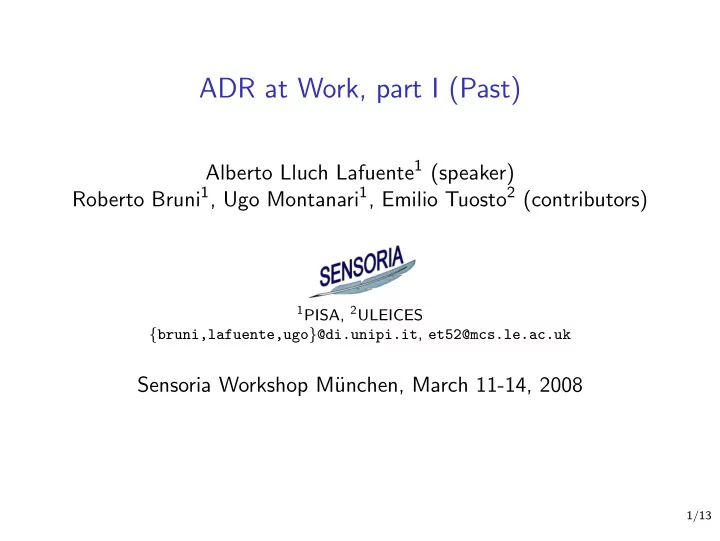

ADR at Work, part I (Past) Alberto Lluch Lafuente 1 (speaker) Roberto Bruni 1 , Ugo Montanari 1 , Emilio Tuosto 2 (contributors) 1 PISA, 2 ULEICES { bruni,lafuente,ugo } @di.unipi.it , et52@mcs.le.ac.uk Sensoria Workshop M¨ unchen, March 11-14, 2008 1/13
What isn’t ADR 2/13
Problem statement Main problems ADR faces: ◮ P1 := Build architectures with structural properties φ . ◮ P1.SOC := applications have holes (services). ◮ P2 := Reconfigure architectures preserving φ . ◮ P2.SOC := Holes (services) to be reconfigured internally. 3/13
Problem statement Main problems ADR faces: ◮ P1 := Build architectures with structural properties φ . ◮ P1.SOC := applications have holes (services). ◮ P2 := Reconfigure architectures preserving φ . ◮ P2.SOC := Holes (services) to be reconfigured internally. Some flaws of existing approaches ◮ P1 via ... Drop&Bind ingredients, check φ : tedious. ◮ P1 via ... Bounded SAT: no guidance, trial&error. ◮ P2 via ... Show φ -preservation: manual. ◮ P2 via ... Monitor φ -preservation: no guarantee. 3/13
Principles of ADR A rchitectural D esign R ewriting? ◮ A lgebra of designs ◮ Type T φ set of architectures that satisfy φ ❀ P1. ◮ Set of design productions (operations, inductive definitions). ◮ D omain ◮ Designs: graphs with interfaces. ◮ Partial designs: designs with holes ❀ P1.SOC. ◮ R ewriting ◮ Rewrite design terms (not designs) d : T → d ′ : T ❀ P2. ◮ Based on conditional term rewriting, SOS ❀ P2.SOC. 4/13
Principles of ADR A rchitectural D esign R ewriting? ◮ A lgebra of designs ◮ Type T φ set of architectures that satisfy φ ❀ P1. ◮ Set of design productions (operations, inductive definitions). ◮ D omain ◮ Designs: graphs with interfaces. ◮ Partial designs: designs with holes ❀ P1.SOC. ◮ R ewriting ◮ Rewrite design terms (not designs) d : T → d ′ : T ❀ P2. ◮ Based on conditional term rewriting, SOS ❀ P2.SOC. No panacea: not everything can be ADRized, but you can be happy if you manage to capture part of your problem. 4/13
Ex1: Pipes-and-Filters (A) 5/13
Ex1: Pipes-and-Filters (D) seq(filter1,par(filter2,filter3)) 6/13
Ex1: Pipes-and-Filters (R) Serializing a filter (and its subfilters) ◮ More in [WRLA’08] 7/13
ADR prototype in Maude Why Maude? ◮ Rewrite Theories match ADR features ◮ Types as sorts (+membership). ◮ Design productions as operations (+axioms). ◮ Conditional term rewriting. ◮ Structural operational semantics (standard encoding). ◮ Built-in Tools: LTL Model Checker, etc. 8/13
ADR prototype in Maude Why Maude? ◮ Rewrite Theories match ADR features ◮ Types as sorts (+membership). ◮ Design productions as operations (+axioms). ◮ Conditional term rewriting. ◮ Structural operational semantics (standard encoding). ◮ Built-in Tools: LTL Model Checker, etc. Playing with ADR in Maude ◮ Implement ADR models. ◮ Specify properties in some logics (e.g. ` a la VLRL, MSO). ◮ Simulate modelling activities (e.g. refinement, model finding). ◮ Analyse models (e.g. via model checking). ◮ Export graphs to dot and XML graph formats. ◮ More in [WRLA’08] 8/13
Analysis example We require some ordering constraints φ among filters. Maude> srew FClient-nt using modelCheck(phi) Solution 7 result FClient: wrap(par(filter(1), Mux-nt, Dmux-nt ... 9/13
Analysis example We require some ordering constraints φ among filters. Maude> srew FClient-nt using modelCheck(phi) Solution 7 result FClient: wrap(par(filter(1), Mux-nt, Dmux-nt ... Does the 7th solution preserve some other ordering constraints ψ . Maude> red modelCheck(sol7,[]psi) . result ModelCheckResult: counterexample... 9/13
Analysis example We require some ordering constraints φ among filters. Maude> srew FClient-nt using modelCheck(phi) Solution 7 result FClient: wrap(par(filter(1), Mux-nt, Dmux-nt ... Does the 7th solution preserve some other ordering constraints ψ . Maude> red modelCheck(sol7,[]psi) . result ModelCheckResult: counterexample... We ask for an architecture satisfying φ and preserving ψ . Maude> srew FClient-nt using modelCheck(phi /\ []psi) Solution 3 result FClient: wrap(seq(filter(0), par(filter(1), ... 9/13
Ex2: SRML Read ADR as ◮ A = well formedness. ◮ D = diagrams. ◮ R = composition. ◮ More in [TGC’07, D5.3b] 10/13
More Examples 11/13
Summary and Conclusion What is ADR? ◮ A lgebra of architectural D esigns that can be R econfigured. ◮ Based on term rewriting, (hierarchical) graphs. What can I do ADR? ◮ Build consistent architectures. ◮ Reconfigure architectures. ◮ Analyse architectures. 12/13
Pointers More on ADR can be found by ◮ Going to http://www.albertolluch.com/adr.html ◮ Reading ◮ Hierarchical Design Rewriting (WRLA’08) ◮ Service Oriented Architectural Design (TGC’07) ◮ D5.3b Requirements for automated reconfiguration and specification of policy run-time support ◮ Style-Based Architectural Reconfigurations (EATCS) ◮ Contacting us. ◮ Pay attention to Roberto’s talk. 13/13
Recommend
More recommend